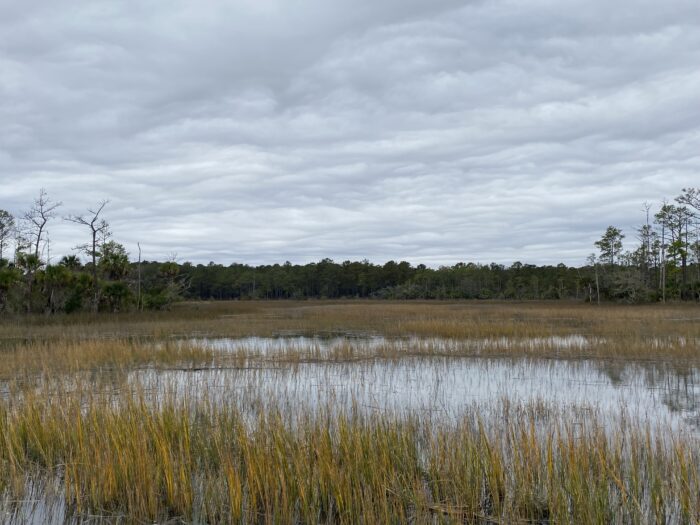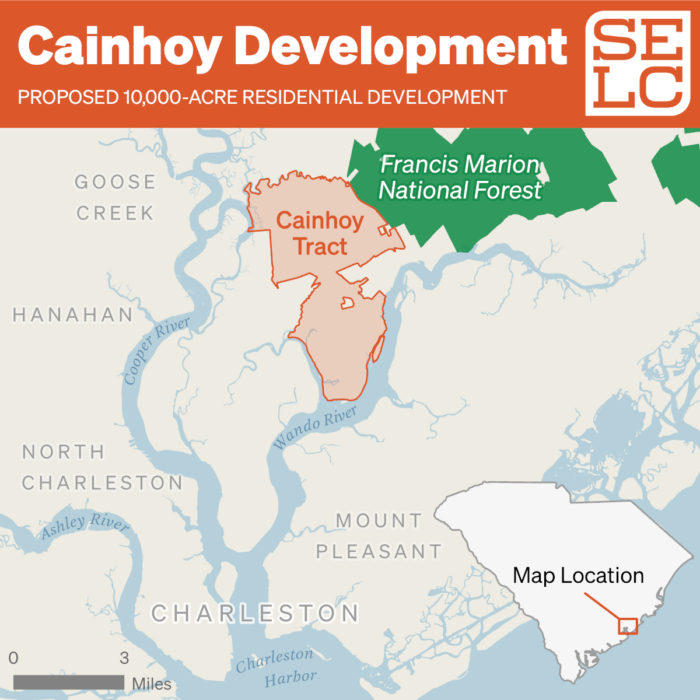Conservation groups challenge permit for Cainhoy development
We just filed a lawsuit on behalf of the Coastal Conservation League, Charleston Waterkeeper, and South Carolina Wildlife Federation over the authorization of a massive development on the Cainhoy peninsula that would fill protective wetlands in an area already vulnerable to flooding.

The almost 10,000-acre proposed Cainhoy development, near the Francis Marion National Forest and already crowded Highway 41, would destroy nearly 200 acres of wetlands that offer critical protection from flooding by storing flood waters.
“The developers should be doing everything they can to minimize destroying wetlands that protect us from flood waters,” said Andrew Wunderley, executive director & waterkeeper of Charleston Waterkeeper. “Damaging hundreds of acres of wetlands is clearly reckless for future occupants of the development.”
In the lawsuit, the groups contend that the U.S. Army Corps of Engineers’ decision to issue the permit violates the Clean Water Act’s prohibition on filling wetlands if there is a less environmentally damaging alternative. During the permitting for this project, the Corps received multiple alternative plans that would have allowed for development of Cainhoy but reduced the impacted wetlands from hundreds of acres to 13.2 acres to zero acres, putting fewer people and homes in the floodplain and reducing flooding risk.
What you need to know about the Cainhoy Peninsula and the protective power of wetlands.
“The Corps itself admits that smarter, safer development alternatives are feasible, so its decision to allow the Cainhoy development to move forward as planned defies common sense,” said Chris DeScherer, director of the Southern Environmental Law Center’s South Carolina office. “Approving a huge new development in such a vulnerable area is completely at odds with ongoing efforts to protect the City of Charleston from flooding and storm surge that happens on a routine basis now.”

In a time when South Carolina’s coast is already vulnerable to rising sea levels and storms that continue to become more powerful, developers should not place new developments in flood-prone areas. The southern section of the Cainhoy peninsula, where thousands of housing units would be built, could see significant flooding and storm surge from a Category 1 hurricane today, in addition to increased risk for flooding over time.
“Not only does the planned development put new residents in the direct path of flood waters, but it will also impact the nearby national forest and wildlife,” said Sara Green, executive director of the South Carolina Wildlife Federation. “The development will remove critical habitat for animals like the red-cockaded woodpecker on the Cainhoy site and negatively impact the national forest, an invaluable natural resource for all.”
Developers are putting the future of Cainhoy residents, as well as significant environmental and cultural resources, at risk simply to make a buck.
Jason Crowley, Coastal Conservation League
The Cainhoy development also borders on the Francis Marion National Forest and will harm that forest and species like the red-cockaded woodpecker that live there and on the Cainhoy site.
“With more practical ways to develop this property, it doesn’t make sense that the Corps would approve the destruction and removal of endangered species and impact hundreds of acres of wetlands in order to place thousands of homes in a vulnerable floodplain,” said Jason Crowley, senior director of Communities and Transportation at the Coastal Conservation League. “Developers are putting the future of Cainhoy residents, as well as significant environmental and cultural resources, at risk simply to make a buck.”
